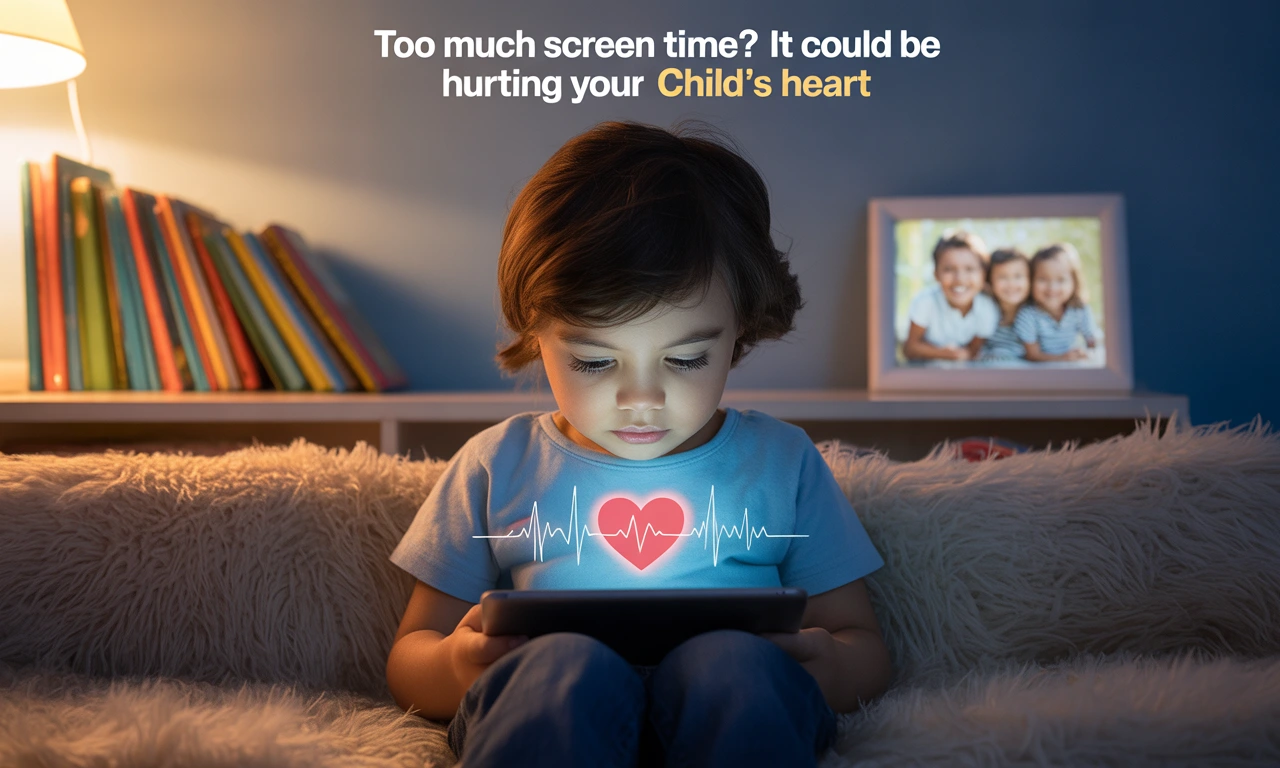Introduction: Why Parents Should Worry About Screen Time and Heart Health
Screen time has long been linked to behavioral issues, attention problems, and poor sleep in children. But now, new research suggests that it may also be quietly harming their heart health.
A recent Journal of the American Heart Association (JAHA) study (August 18, 2025) found that every additional hour of discretionary screen use—like gaming, streaming, or social media—raises children’s cardiometabolic risk. And when poor sleep enters the picture, the risks multiply significantly.
This finding shines a light on a modern parenting challenge: balancing technology’s benefits with its hidden dangers.
Understanding Cardiometabolic Risk in Children
Cardiometabolic risk refers to the likelihood of developing chronic diseases like heart disease and type 2 diabetes based on certain measurable health factors. While once primarily adult concerns, these red flags are appearing in kids at younger ages.
Key Risk Markers in Children
- High blood pressure
- Increased waist circumference (abdominal fat)
- Poor cholesterol profiles (low HDL, high non-HDL)
- Insulin resistance (elevated blood sugar levels)
These markers together create a cardiometabolic risk score, which the JAHA study used to measure how lifestyle factors—like screen time and sleep—affect children’s health.
The Link Between Screen Time and Children’s Heart Health
The study revealed a dose–response relationship: more screen time equals greater health risks. Even just one extra hour daily of non-educational screen use raised children’s cardiometabolic scores.
Why Screen Time Matters
- Encourages sedentary behavior, reducing physical activity.
- Promotes unhealthy snacking during screen use.
- Exposes kids to blue light, disrupting sleep cycles.
- Displaces time for outdoor play and exercise.
The result? A lifestyle shift that silently contributes to early signs of cardiovascular and metabolic diseases.
The Role of Sleep: A Risk Multiplier
One of the most striking findings in the JAHA study is the interaction between sleep and screen time.
- Children who slept less than recommended showed far higher increases in cardiometabolic risk from screen time than those who got enough rest.
- Poor sleep affects metabolism, increases cortisol levels, and encourages overeating—compounding screen-related harms.
Recommended Sleep Durations for Kids
- Ages 6–13: 9–11 hours per night
- Teens (14–17): 8–10 hours per night
Without adequate rest, children’s bodies become more vulnerable to the harmful effects of screens.
Digital Health for Kids: What Parents Should Know
This study goes beyond warnings about “screen addiction.” It suggests that children’s digital habits may shape their long-term physical health.
Key Takeaways for Families
- Keep discretionary screen time under two hours daily for school-aged kids.
- Prioritize healthy sleep hygiene with consistent bedtimes and tech-free nights.
- Encourage daily physical activity—from structured sports to unstructured play.
Early Warning Signs Screen Time May Be Affecting Heart Health
Parents should watch for these red flags:
- Struggling to wake up or persistent fatigue
- Rapid weight gain or reduced stamina
- Irritability, mood swings, or difficulty focusing
- Unexplained high blood pressure or poor cholesterol during checkups
Often brushed off as behavioral, these may indicate deeper cardiometabolic concerns.
Practical Strategies to Support Healthy Digital Habits
Finding balance doesn’t mean banning screens—it means creating mindful routines.
1. Set Clear Screen Time Limits
Define daily boundaries for non-educational use.
2. Create Tech-Free Zones
Keep bedrooms, mealtimes, and family activities screen-free.
3. Implement a Digital Curfew
Turn off devices at least an hour before bedtime to promote melatonin production.
4. Model Healthy Habits
Kids copy adults. Show balanced screen use and prioritize active living.
5. Make Physical Activity Fun
Incorporate sports, outdoor games, or family walks to offset sedentary screen use.
FAQs About Screen Time and Children’s Heart Health
Q1. How much screen time is safe for kids?
The American Academy of Pediatrics (AAP) recommends no more than two hours of recreational screen time per day for school-aged children.
Q2. Does educational screen time count as risky?
Educational use is less concerning, but it should still be balanced with physical activity and rest.
Q3. What’s the biggest health risk from too much screen time?
Long-term risks include obesity, insulin resistance, and heart disease—all linked to cardiometabolic dysfunction.
Q4. How does screen time affect sleep?
Blue light suppresses melatonin, making it harder for kids to fall asleep and stay asleep.
Q5. Can physical activity offset screen-related risks?
Yes. Daily movement significantly reduces the cardiometabolic impact of sedentary behavior.
Q6. Should I remove screens from my child’s bedroom?
Absolutely. Keeping bedrooms screen-free improves both sleep quality and self-regulation.
Conclusion: A New Era of Screen Awareness
This JAHA study underscores a powerful truth: screen time isn’t just a lifestyle concern—it’s a heart health issue.
As parents, caregivers, and educators, we can reshape digital habits to ensure children grow up healthy, active, and resilient. By limiting discretionary screen time, protecting sleep, and encouraging movement, we can guard against long-term health risks and give kids the strong, healthy futures they deserve.



